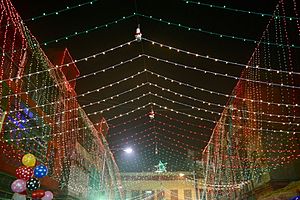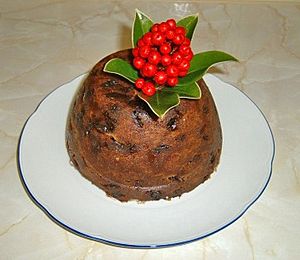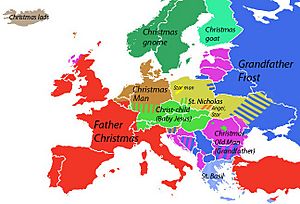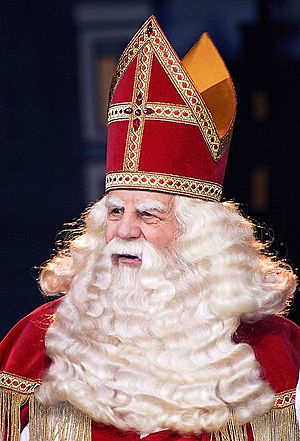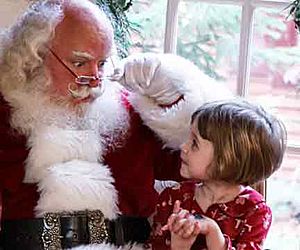Christmas traditions facts for kids
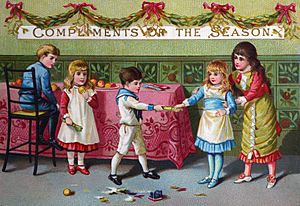
Christmas traditions are all the special ways people celebrate Christmas. These include customs, religious practices, and fun activities. Many traditions are different from country to country. But some are celebrated the same way everywhere.
Christmas traditions have many different beginnings. Some come from Christian beliefs. Others are more cultural or just for fun, not directly from religion. Christmas traditions have also changed a lot over hundreds of years. They look different depending on the time period and where you are in the world.
Contents
Why do people go to church at Christmas?
Christmas Day is a very important day for Christians. Many Christians attend a church service on Christmas Eve or Christmas Day. This is a big part of celebrating the Christmas season. Christmas, along with Easter, is when the most people go to church each year. For example, in 2015, about 2.5 million people went to Christmas services in the United Kingdom.
How do people decorate for Christmas?

People have decorated for Christmas for a very long time. In the 15th century, people in London decorated their homes and churches with green plants. They used holm, ivy, and bays. The heart-shaped leaves of ivy were said to mean Jesus coming to Earth. Holly was thought to protect against bad things. Its thorns and red berries reminded people of the Crown of Thorns Jesus wore.
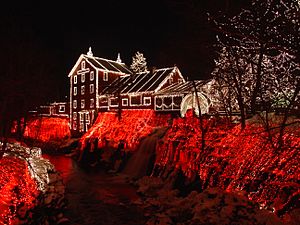
Nativity scenes have been around since the 10th century. Saint Francis of Assisi made them very popular in 1223. They quickly spread across Europe. Different kinds of decorations grew from local traditions. Some are simple, while others are very fancy. Famous Nativity scenes include the colorful Kraków szopka in Poland. These look like Kraków's old buildings. Italian presepi are also well-known. In some places, like Sicily, people even create living Nativity scenes. The first Christmas decorations sold in stores appeared in Germany in the 1860s. These were inspired by paper chains made by children.
The main colors for Christmas decorations are red, green, and gold. Red stands for the blood of Jesus. Green means eternal life, like evergreen trees that stay green all winter. Gold was one of the gifts given to baby Jesus by the Magi. It symbolizes royalty.

The Christmas tree was first used by German Lutherans in the 16th century. A record shows a Christmas tree in a church in 1539. In the United States, German Lutherans brought this tradition with them. They even put lighted candles on their trees. Many people put a star on top of the tree. This star symbolizes the Star of Bethlehem. Some people also use an angel to top the tree. This represents the angels in the story of Jesus' birth. The Christmas tree custom came to Britain from Germany. It became very popular during the time of Queen Victoria. By the 1870s, people in the United States also started putting up Christmas trees. Trees are decorated with lights and ornaments.
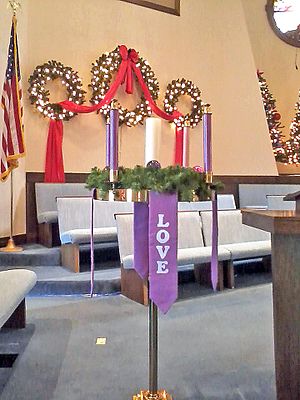
Since the 16th century, the poinsettia plant has been linked to Christmas. It comes from Mexico and its shape reminds people of the Star of Bethlehem. Other popular holiday plants include holly, mistletoe, and Christmas cactus. Homes are decorated with these plants, along with garlands and evergreen leaves. Many families also display Christmas villages. Outside, houses are decorated with lights, sleighs, snowmen, and other Christmas figures.
Mistletoe is a special plant in European stories. It's an evergreen plant that grows on trees. It's common to hang mistletoe in the house at Christmas. If two people stand under it, they might share a kiss!
Other traditional decorations include bells, candles, candy canes, stockings, wreaths, and angels. Wreaths are made of evergreen leaves. They help Christians get ready for the Advent season. Candles in windows show that Christians believe Jesus is the light of the world.
Streets are often decorated with Christmas lights and banners. Music plays from speakers, and large Christmas trees are put in public places. Many towns and shopping areas display decorations. People also use brightly colored paper to wrap gifts. In some countries, Christmas decorations are taken down on Twelfth Night.
What are Nativity plays?

For Christians, watching a Nativity play is one of the oldest Christmas traditions. The first reenactment of the Nativity of Jesus happened in 1223. That year, Francis of Assisi set up a Nativity scene outside his church in Italy. Children sang Christmas carols about Jesus' birth. This event grew bigger each year. People traveled far to see Francis's play, which included drama and music. Nativity plays then spread across Europe and are still popular today. Churches, schools, and theaters often have Nativity plays. In some countries, like France and Mexico, Nativity plays are even performed outdoors in the streets.
What kind of music is played at Christmas?

The first Christmas hymns appeared in the 4th century. Over time, popular Christmas songs in local languages developed. This happened a lot in Italy, thanks to Francis of Assisi. English Christmas carols first appeared in a book in 1426. These were probably sung by groups who went from house to house.

Songs now called carols were originally folk songs sung during celebrations. Later, carols started to be sung in church. Many carols have a special sound because they are based on old musical patterns. Some carols like "Good King Wenceslas" and "The Holly And The Ivy" are very old. They are still sung regularly today. "Adeste Fideles" (O Come all ye faithful) is from the mid-1700s.
In 1818, "Silent Night" was composed in Austria. This became a very famous Christmas song. Many classic English carols first appeared in a book called Christmas Carols Ancient and Modern in 1833. This helped bring back interest in Christmas carols.
New Christmas songs that were not religious started to appear in the late 1700s. "Deck the Halls" is from 1784. The American song "Jingle Bells" was first published in 1857. In the 19th and 20th centuries, many new holiday songs were created.
What special foods are eaten at Christmas?
A special Christmas family meal is a very important part of the holiday. The food eaten is different in each country. In Sicily, people might eat 12 kinds of fish on Christmas Eve. In the United Kingdom, a typical Christmas meal includes turkey, goose, or another large bird. It also has gravy, potatoes, and vegetables. Special desserts are made, like Christmas pudding, mince pies, and Yule log cake.
In Poland and other parts of Eastern Europe, fish is often the main course. But richer meats like lamb are becoming more common. In Sweden, people have a special smörgåsbord with ham, meatballs, and herring. In Germany, France, and Austria, goose and pork are popular. Beef, ham, and chicken are eaten in many ways around the world. The Maltese drink Imbuljuta tal-Kastan, a chocolate and chestnut drink. Slovenes make a traditional Christmas bread called potica. France has bûche de Noël, and Italy has panettone.
Eating sweets and chocolates is popular everywhere. German stollen and marzipan cake are sweet Christmas treats. Oranges have long been a special Christmas food. This is because they were one of the few fruits available in northern countries during winter. Eggnog is a sweet, creamy drink made with milk, sugar, and eggs. Sometimes, brandy or rum is added. It's often topped with cinnamon or nutmeg.
Do people send Christmas cards?
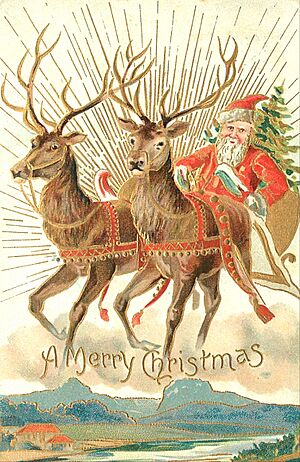
Christmas cards are special messages sent between friends and family before Christmas Day. The first commercial Christmas card was made in London in 1843. It said, "wishing you a Merry Christmas and a Happy New Year." Sending cards has become very popular. Many people now send E-cards too.
Christmas cards have artwork related to the season. Some show the Christmas story, like scenes of Jesus' birth. Others have Christian symbols like the Star of Bethlehem or a white dove. Other cards are not religious. They show Christmas traditions, like Santa Claus, candles, holly, or snow scenes. There are also funny cards and cards that show old-fashioned scenes.
Some people like cards with a poem or a Bible verse. Others prefer a general "Season's greetings."
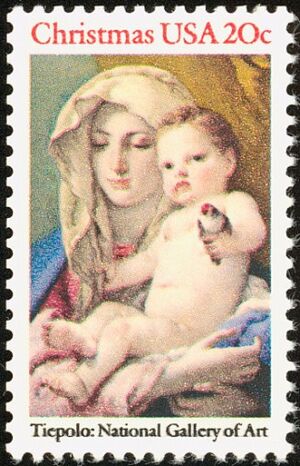
What are Christmas stamps?
Many countries have made special commemorative stamps for Christmas. People use these stamps to mail their Christmas cards. Stamp collectors also like them. These are regular postage stamps and can be used all year. They usually go on sale in October or December.
Why do people give gifts at Christmas?
Giving gifts is a main part of modern Christmas celebrations. This makes Christmas the busiest time of year for stores. People exchange gifts because of the Christian tradition linked to Saint Nicholas. Also, the Magi gave gifts of gold, frankincense, and myrrh to baby Jesus. The idea of giving gifts is deeply connected to the Christmas story.
Who brings gifts at Christmas?
Many figures are linked to Christmas gift-giving. These include Father Christmas, also known as Santa Claus. Other names are Père Noël, the Christkind, Kris Kringle, and Joulupukki.
The most famous gift-giver today is the red-dressed Santa Claus. His name comes from the Dutch word Sinterklaas, which means Saint Nicholas. Nicholas was a Greek bishop in the 4th century. He was known for caring for children and giving gifts. His feast day, December 6, became a day for giving gifts in many countries.
Saint Nicholas traditionally wore a bishop's outfit. He would ask children about their behavior before deciding if they deserved a gift. By the 13th century, Saint Nicholas was well-known. During the Protestant Reformation, many Protestants changed the gift-bringer to the Christ Child. The date for giving gifts also changed from December 6 to Christmas Eve.
The modern image of Santa Claus was created in the United States. Writers like Washington Irving and cartoonist Thomas Nast helped shape this image. In 1809, Saint Nicholas was named the patron saint of New York City. At first, Santa Claus was drawn in bishop's robes. But over time, he started to look more like the Santa we know today. By the 1880s, Nast's Santa looked like the modern figure. Advertisers made this image standard in the 1920s.
Father Christmas is an older English character. He was a jolly, bearded man who represented good cheer at Christmas. He was first recorded in the early 1600s. He was linked to holiday fun, not gift-giving. In Victorian Britain, his image changed to match Santa's. The French Père Noël also became similar to Santa.
In Italy, Babbo Natale is like Santa Claus. But La Befana brings gifts on the eve of the Epiphany. The story says La Befana set out to bring gifts to baby Jesus but got lost. Now, she brings gifts to all children. In some cultures, Santa Claus has helpers like Knecht Ruprecht or Black Peter. In other stories, elves make the toys. Santa's wife is Mrs. Claus.
In some Latin American countries, people believe Santa makes the toys. Then, he gives them to the Baby Jesus, who delivers them to children's homes. This combines old religious beliefs with the Santa Claus image.
In places like Austria and parts of Germany, the Christkind brings presents. Greek children get gifts from Saint Basil on New Year's Eve. The German St. Nikolaus is different from the Weihnachtsmann (German Santa Claus). St. Nikolaus wears a bishop's dress and brings small gifts on December 6. He is joined by Knecht Ruprecht.
In Poland, different figures bring gifts depending on the region. St Nicholas is common in central and northeast areas. The Starman is popular in Greater Poland. Baby Jesus is unique to Upper Silesia. The Little Star and Little Angel are common in the South. Grandfather Frost is less common. It's important to know that across Poland, St Nicholas is the gift giver on Saint Nicholas Day on December 6.
See also
 In Spanish: Tradiciones navideñas para niños
In Spanish: Tradiciones navideñas para niños


